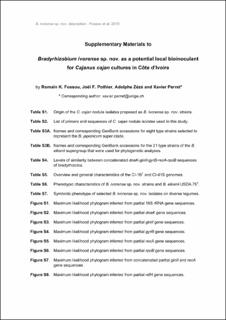Bitte benutzen Sie diese Kennung, um auf die Ressource zu verweisen:
https://doi.org/10.21256/zhaw-19075| Publikationstyp: | Beitrag in wissenschaftlicher Zeitschrift |
| Art der Begutachtung: | Peer review (Publikation) |
| Titel: | Bradyrhizobium ivorense sp. nov. as a potential local bioinoculant for Cajanus cajan cultures in Côte d’Ivoire |
| Autor/-in: | Fossou, Romain K. Pothier, Joël F. Zézé, Adolphe Perret, Xavier |
| et. al: | No |
| DOI: | 10.1099/ijsem.0.003931 10.21256/zhaw-19075 |
| Erschienen in: | International Journal of Systematic and Evolutionary Microbiology |
| Band(Heft): | 70 |
| Heft: | 2 |
| Seite(n): | 1421 |
| Seiten bis: | 1430 |
| Erscheinungsdatum: | 2-Jan-2020 |
| Verlag / Hrsg. Institution: | Microbiology Society |
| ISSN: | 1466-5026 1466-5034 |
| Sprache: | Englisch |
| Schlagwörter: | Nitrogen fixation; Legume; Root nodule; Pigeonpea; Africa |
| Fachgebiet (DDC): | 570: Biologie |
| Zusammenfassung: | For many smallholder farmers of Sub-Saharan Africa, pigeonpea (Cajanus cajan) is an important crop to make ends meet. To ascertain the taxonomic status of pigeonpea isolates of Côte d’Ivoire previously identified as bradyrhizobia, a polyphasic approach was applied to strains CI-1BT, CI-14A, CI-19D and CI-41S. Phylogeny of 16S ribosomal RNA (rRNA) genes placed these nodule isolates in a separate lineage from current species of the B. elkanii super clade. In phylogenetic analyses of single and concatenated partial dnaK, glnII, gyrB, recA and rpoB sequences, the C. cajan isolates again formed a separate lineage, with strain CI-1BT sharing the highest sequence similarity (95.2 %) with B. tropiciagri SEMIA 6148T. Comparative genomic analyses corroborated the novel species status, with 86 % ANIb and 89 % ANIm as the highest average nucleotide identity (ANI) values with B. elkanii USDA 76T. Although CI-1BT, CI-14A, CI-19D and CI-41S shared similar phenotypic and metabolic properties, growth of CI-41S was slower in/on various media. Symbiotic efficacy varied significantly between isolates, with CI-1BT and CI-41S scoring on the C. cajan ‘Light-Brown’ landrace as the most and least proficient bacteria, respectively. Also proficient on Vigna radiata (mung bean), Vigna unguiculata (cowpea, niébé) and additional C. cajan cultivars, CI-1BT represents a potential bioinoculant adapted to local soil conditions and capable of fostering the growth of diverse legume crops in Côte d'Ivoire. Given the data presented here, we propose the 19 C. cajan isolates to belong to a novel species called Bradyrhizobium ivorense sp. nov., with CI-1BT (=CCOS 1862T=CCMM B1296T) as a type strain. |
| URI: | https://digitalcollection.zhaw.ch/handle/11475/19075 |
| Volltext Version: | Publizierte Version |
| Lizenz (gemäss Verlagsvertrag): | CC BY-NC 4.0: Namensnennung - Nicht kommerziell 4.0 International |
| Departement: | Life Sciences und Facility Management |
| Organisationseinheit: | Institut für Umwelt und Natürliche Ressourcen (IUNR) |
| Publiziert im Rahmen des ZHAW-Projekts: | MinION2FixID: fast and reliable legume root nodule bacteria identification using nanopore sequencing technology MALDI-TOF MS for microorganism identification: from pattern recognition towards marker based approaches |
| Enthalten in den Sammlungen: | Publikationen Life Sciences und Facility Management |
Dateien zu dieser Ressource:
| Datei | Beschreibung | Größe | Format | |
|---|---|---|---|---|
| Fossou2020.pdf | Publication | 529.46 kB | Adobe PDF |  Öffnen/Anzeigen |
| Fossou2020_SM.pdf | Supplementary material | 849.2 kB | Adobe PDF |  Öffnen/Anzeigen |
Zur Langanzeige
Fossou, R. K., Pothier, J. F., Zézé, A., & Perret, X. (2020). Bradyrhizobium ivorense sp. nov. as a potential local bioinoculant for Cajanus cajan cultures in Côte d’Ivoire. International Journal of Systematic and Evolutionary Microbiology, 70(2), 1421–1430. https://doi.org/10.1099/ijsem.0.003931
Fossou, R.K. et al. (2020) ‘Bradyrhizobium ivorense sp. nov. as a potential local bioinoculant for Cajanus cajan cultures in Côte d’Ivoire’, International Journal of Systematic and Evolutionary Microbiology, 70(2), pp. 1421–1430. Available at: https://doi.org/10.1099/ijsem.0.003931.
R. K. Fossou, J. F. Pothier, A. Zézé, and X. Perret, “Bradyrhizobium ivorense sp. nov. as a potential local bioinoculant for Cajanus cajan cultures in Côte d’Ivoire,” International Journal of Systematic and Evolutionary Microbiology, vol. 70, no. 2, pp. 1421–1430, Jan. 2020, doi: 10.1099/ijsem.0.003931.
FOSSOU, Romain K., Joël F. POTHIER, Adolphe ZÉZÉ und Xavier PERRET, 2020. Bradyrhizobium ivorense sp. nov. as a potential local bioinoculant for Cajanus cajan cultures in Côte d’Ivoire. International Journal of Systematic and Evolutionary Microbiology. 2 Januar 2020. Bd. 70, Nr. 2, S. 1421–1430. DOI 10.1099/ijsem.0.003931
Fossou, Romain K., Joël F. Pothier, Adolphe Zézé, and Xavier Perret. 2020. “Bradyrhizobium Ivorense Sp. Nov. As a Potential Local Bioinoculant for Cajanus Cajan Cultures in Côte d’Ivoire.” International Journal of Systematic and Evolutionary Microbiology 70 (2): 1421–30. https://doi.org/10.1099/ijsem.0.003931.
Fossou, Romain K., et al. “Bradyrhizobium Ivorense Sp. Nov. As a Potential Local Bioinoculant for Cajanus Cajan Cultures in Côte d’Ivoire.” International Journal of Systematic and Evolutionary Microbiology, vol. 70, no. 2, Jan. 2020, pp. 1421–30, https://doi.org/10.1099/ijsem.0.003931.
Alle Ressourcen in diesem Repository sind urheberrechtlich geschützt, soweit nicht anderweitig angezeigt.